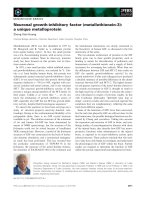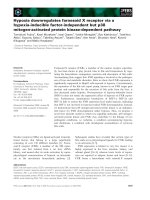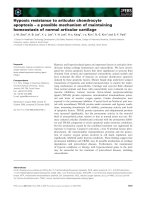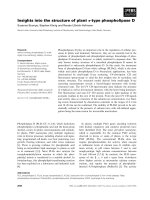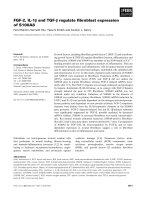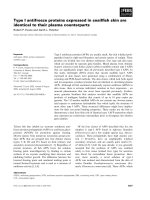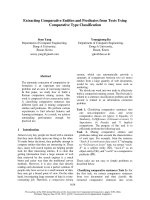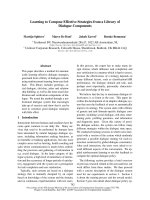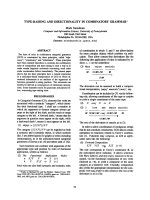Báo cáo khóa học: Type 2 isopentenyl diphosphate isomerase from a thermoacidophilic archaeon Sulfolobus shibatae potx
Bạn đang xem bản rút gọn của tài liệu. Xem và tải ngay bản đầy đủ của tài liệu tại đây (311.49 KB, 7 trang )
Type 2 isopentenyl diphosphate isomerase from a thermoacidophilic
archaeon
Sulfolobus shibatae
Satoshi Yamashita, Hisashi Hemmi, Yosuke Ikeda, Toru Nakayama and Tokuzo Nishino
Department of Biomolecular Engineering, Graduate School of Engineering, Tohoku University, Miyagi, Japan
Although isopentenyl diphosphate–dimethylallyl diphos-
phate isomerase is thought to be essential for archaea
because they use the mevalonate pathway, its corresponding
activity has not been detected in any archaea. A novel type of
the enzyme, which has no sequence similarity to the known,
well-studied type of enzymes, was recently reported in some
bacterial strains. In this study, we describe the cloning of a
gene of a homologue of the novel bacterial isomerase from a
thermoacidophilic archaeon Sulfolobus shibatae. The gene
was heterologously expressed in Escherichia coli,andthe
recombinant enzyme was purified and characterized. The
thermostable archaeal enzyme is tetrameric, and requires
NAD(P)H and Mg
2+
for activity, similar to its bacterial
homologues. Using its apoenzyme, we were able to confirm
that the archaeal enzyme is strictly dependent on FMN.
Moreover, we provide evidence to show that the enzyme
also has NADH dehydrogenase activity although it catalyzes
the isomerase reaction without consuming any detectable
amount of NADH.
Keywords: isopentenyl diphosphate–dimethylallyl diphos-
phate isomerase; isoprenoid; archaea; flavoprotein; NADH
dehydrogenase.
Isoprenoid compounds are the most diverse family of
metabolites found in nature. They are necessary for all living
organisms because they are functional parts of important
compounds, including vitamins, hormones, respiratory
quinones, and archaeal membranes [1]. The majority of
isoprenoid compounds are synthesized from linear prenyl
diphosphates, which are formed via the consecutive con-
densation of isopentenyl diphosphate (IPP), the active
isoprene C
5
-unit, to its highly electrophilic isomer dimethyl-
allyl diphosphate (DMAPP).
Isopentenyl diphosphate–dimethylallyl diphosphate
isomerase (IPP isomerase; EC 5.3.3.2) catalyzes the inter-
conversion of IPP and DMAPP and is a key enzyme in the
biosynthesis of isoprenoids [2]. Based on studies using
eukaryotes, IPP has been shown to be synthesized from
acetyl-CoA via the well-known mevalonate pathway and is
further converted to DMAPP by IPP isomerase [3]. On the
other hand, many bacteria, green algae, and chloroplasts of
higher plants have recently been shown to use a different
isoprenoid biosynthetic pathway, which is referred to as the
nonmevalonate pathway [4,5]. It has been reported that IPP
and DMAPP are synthesized separately in Escherichia coli
and that the IPP isomerase gene was not essential for this
organism [6]. Synechocystis sp. strain PCC6803, which also
utilizes the nonmevalonate pathway for the biosynthesis of
isoprenoids, was shown to be deficient in IPP isomerase
activity [7]. In short, IPP isomerase is necessary for the
biosynthesis of isoprenoid compounds via the mevalonate
pathway, and unnecessary for that of the nonmevalonate
pathway. However, despite the sole utilization of the
mevalonate pathway for isoprenoid biosynthesis, many
archaea and some bacteria lack homologues of IPP
isomerase genes in their genome sequences [8].
Kaneda et al. recently cloned the gene fni from Strepto-
myces sp. strain CL190, which possesses genes of the
mevalonate pathway as a cluster in addition to those of
the nonmevalonate pathway [9]. The fni gene was located
in the cluster of mevalonate pathway genes [10]. They
demonstrated that fni encodes a totally new type of IPP
isomerase designated as type 2 IPP isomerase. This new
enzyme characteristically requires redox coenzymes, i.e.
both FMN and NAD(P)H, for activity while the known
IPP isomerase (type 1 IPP isomerase) has no cofactor
requirement except for divalent metal ions. As the result of a
homology search, it was found that fni homologues are
present in the whole-genome sequences of many organisms,
including archaea and some bacteria.
Although IPP isomerase is thought to be essential for
archaea because they use the mevalonate pathway, the
activity of IPP isomerase has not been detected in any
archaea to date. The existence of homologues of fni in their
genomes strongly suggests that archaea possess type 2 IPP
isomerases. To investigate this issue further, we cloned a
gene of the homologue of fni from the thermoacidophilic
archaeon Sulfolobus shibatae. The gene was expressed in
E. coli, and the recombinant enzyme was purified and
Correspondence to H. Hemmi, Department of Biomolecular
Engineering, Graduate School of Engineering, Tohoku University,
Aoba-yama 07. Sendai, Miyagi 980–8579, Japan.
Fax: + 81 22 2177293, Tel.: + 81 22 2177272,
E-mail:
Abbreviations: DMAPP, dimethylallyl diphosphate; GGPP, geranyl-
geranyl diphosphate; IPP, isopentenyl diphosphate.
Database: The nucleotide sequences reported in this paper are avail-
able from the DDBJ/GenBank
TM
/EMBL Data Bank under the
accession numbers AB118244 and AB118245.
Enzyme: isopentenyl diphosphate–dimethylallyl diphosphate
isomerase (IPP) isomerase (EC 5.3.3.2).
(Received 13 November 2003, revised 11 January 2004,
accepted 26 January 2004)
Eur. J. Biochem. 271, 1087–1093 (2004) Ó FEBS 2004 doi:10.1111/j.1432-1033.2004.04010.x
confirmed to have IPP isomerase activity. Moreover, the
enzyme was used in a detailed study of the unique properties
of type 2 IPP isomerase, especially its requirement for the
redox coenzymes.
Materials and methods
Materials
[1-
14
C]IPP was purchased from Amersham Biosciences.
Dimethylallyl diphosphate was donated by Drs K. Ogura
and T. Koyama, Tohoku University. All other chemicals
were of analytical grade.
General procedures
Restriction enzyme digestion, transformation, hybridiza-
tion, and other standard molecular biology techniques were
carried out as described by Sambrook and Russell [11].
Cloning of the gene encoding archaeal IPP isomerase
We previously cloned the plasmid pGGPS1 containing
ORF3 [12], which is homologous with fni,fromaSulfo-
lobus acidocaldarius genomic library. On the basis of the
nucleotide sequence of pGGPS1, the ORF3 was amplified
using the PCR primers 5¢-TAAATCATGATAACGG
GCATGACTGG-3¢ and 5¢-TTAAGGGATCCATATT
CTTCTCTTTCTAAC-3¢. The genome of S. acidocalda-
rius, as the template, and KOD DNA polymerase (TOY-
OBO) were used for the reaction. The amplified fragment
was subcloned into pUC119 to yield the plasmid ORF3-
pUC119. We used a 952 bp SacI/XbaI fragment containing
nearly full-length ORF3, which was derived from ORF3-
pUC119, as a probe for colony hybridization and
subsequently isolated eight positive clones from 32 000
colonies of the S. shibatae genomic library. The plasmid
g43–2, from one of the positive clones, was sequenced and
found to contain an open reading frame of 1107 bp (termed
idi herein). The idi gene was amplified using the PCR
primers 5¢-TAAGAGGTAGGC
CATATGCC-3¢ and
5¢-CTTAATTCGTCA
GGATCCTTATTCTCTC-3¢,which
include newly introduced NdeIandBamHI restriction
sites (underlined), respectively. The plasmid g43-2, as the
template, and KOD DNA polymerase were used for the
reaction. The amplified fragment was cleaved with NdeIand
BamHIandthenligatedintotheNdeI-BamHI sites of the
pET-15b vector (Novagen). The resulting plasmid was
designated as pET-idi.
Expression and purification of recombinant enzyme
E. coli BL21(DE3) transformed with pET-idi was cultivated
in 3 L of M9YG broth supplemented with ampicillin
(50 mgÆL
)1
). When the D
600
of the culture reached
0.5, 0.1 m
M
(final concentration) isopropyl thio-b-
D
-galactoside was added to the medium. After an additional
overnight cultivation, the cells were harvested and disrupted
by sonication in Start buffer composed of 20 m
M
phosphate
buffer (pH 7.4), 0.5
M
NaCl, and 10 m
M
imidazole. The
homogenate was centrifuged at 20 000 g for 20 min, and
the supernatant was recovered as a crude extract. The crude
extract was heated at 55 °C for 60 min, and the denatured
proteins were removed by centrifugation at 20 000 g for
20 min. The supernatant was applied to a HisTrap column
(Amersham Biosciences) previously equilibrated with the
Start buffer. The resin was washed with the Start buffer, and
the protein bound to the resin was then eluted with 20 m
M
phosphate buffer (pH 7.4), containing 0.5
M
NaCl and
0.5
M
imidazole. Active fractions were dialyzed overnight at
4 °C against buffer A composed of 10 m
M
Tris/Cl buffer
(pH 7.7), 1 m
M
EDTA, and 10 m
M
2-mercaptoethanol,
and then used for characterization. The level of purification
was determined by SDS/PAGE (15% polyacrylamide).
To determine the subunit structure of S. shibatae IPP
isomerase, the purified enzyme was loaded onto a Superdex
200 HR 10/30 gel-filtration column (Amersham Biosci-
ences) and eluted with buffer A. The molecular mass of the
enzyme was calculated based on a correlation curve made
by means of a Gel Filtration HMW Calibration Kit
(Amersham Biosciences).
Preparation of apoenzyme
The purified idi product was dialyzed against 10 m
M
acetate
buffer (pH 4.5) containing 1 m
M
EDTA, 10 m
M
2-merca-
ptoethanol, 2
M
KBr for 96 h at 4 °C. During the dialysis,
activated charcoal (4 gÆL
)1
) was added to absorb the
released FMN. After the complete loss of FMN absorb-
ance, the dialysis buffer was changed to buffer A, and the
dialysis continued overnight. The resulting apoenzyme was
used in a reconstitution experiment. Absorption spectra of
the purified idi product and the apoenzyme were recorded
on a visible spectrophotometer (SpectraMax 340PC
384
;
Molecular Devices).
Assay for IPP isomerase
The assay system is based on the acid-lability of DMAPP
when exposed to acid [13]. The standard assay mixture
contained, in a final volume of 50 lL, 5 nmol of [1-
14
C]IPP
(0.19 GBqÆmmol
)1
), 0.25 lmol of MgCl
2
,2 lmol of malate/
NaOH buffer (pH 6.0), 25 nmol of NADH, 0.5 nmol of
FMN, and a suitable amount of enzyme. This mixture
was incubated at 60 °C for 10 min, and the reaction was
terminated by adding 0.2 mL of 25% concentrated HCl in
MeOH and 0.5 mL of H
2
O saturated with NaCl, followed
by incubation at 37 °C for 10 min. This mixture was then
extracted twice with 0.5 mL pentane. The pentane extracts
were added, and the radioactivity was measured. To
determine the dissociation constant for FMN, various
concentrations of FMN were previously added to the assay
mixture using the apoenzyme and lacking NADH, and the
mixtures were placed on ice for 30 min and then used for
enzyme assay by adding NADH. All kinetic parameters
were calculated using the
ENZYMEKINETICS
software pro-
gram (Trinity Software) using the nonlinear-regression
method.
Detection of DMAPP production
The conversion of IPP to DMAPP catalyzed by IDI was
detected using the same reaction mixture as that used in the
IPP isomerase assay, except for the addition of a suitable
1088 S. Yamashita et al. (Eur. J. Biochem. 271) Ó FEBS 2004
amount of purified Sulfolobus acidocaldarius geranylger-
anyl diphosphate (GGPP) synthase into the mixture [12].
This mixture was incubated at 60 °C for 10 min, and the
reaction was stopped by chilling the mixture in an ice bath.
The mixture was shaken with 600 lL of 1-butanol saturated
with H
2
O. The butanol layer, extracting GGPP, was washed
with water saturated with NaCl, and the radioactivity in
100 lL of the butanol layer was measured.
NADH dehydrogenase assay
The standard assay mixture for the NADH dehydrogenase
activity of S. shibatae IDI contained, in a final volume of
100 lL, 10 nmol of IPP, 0.5 lmol of MgCl
2
,10nmolof
NADH, 5 lmol of a malate/NaOH buffer (pH 6.0), and
14.4 pmol (as monomer) of the purified enzyme. To
minimize the interference by the absorption of FMN,
FMN was not added to the mixture, except for that bound
to IDI. This mixture was incubated at 60 °C for 20 min,
and the reaction was stopped by adding 100 lLofwater
saturated with NaCl. The absorbance of NADH at 340 nm
was measured with a visible spectrophotometer.
Measurement of the oxygen peroxide production
The assay mixture contained, in a final volume of 100 lL, a
variable concentration of NADH, 5 lmol of a succinate/
NaOH buffer (pH 6.0), and 28.8 pmol of the purified
enzyme. This mixture was incubated at 37 °C for 20 min,
and 100 lL of chromogenic assay solution, containing
1 lmol of phenol, 1.25 lmol of 4-aminoantipyrine, and
650 mU of horseradish peroxidase, was then added. The
absorbance of quinoneimine dye at 505 nm and that of
NADH at 340 nm were measured immediately after the
solution was mixed.
Results
Cloning and heterologous expression of the gene
encoding archaeal IPP isomerase
In our previous studies, we cloned the GGPP synthase gene
(gds) from a thermoacidophilic archaeon S. acidocaldarius
with some ORFs in the proximity of gds [12]. One of the
ORFs, designated ORF3 (accession number: AB118245), is
located next to gds, and both genes are thought to exist in an
operon. A homology search revealed that ORF3 has a high
sequence similarity with fni, the type 2 IPP isomerase gene
from Streptomyces sp. strain CL190. Thus we attempted to
express the ORF in E. coli to determine whether the gene
also encodes the new type IPP isomerase. However, the
recombinant expression of ORF3 in E. coli was unsuccess-
ful: we were not able to detect thermostable IPP isomerase
activity in the crude extract of the transformed E. coli.
Therefore we isolated a homologue of fni from S. shibatae,a
relative of S. acidocaldarius. By colony hybridization using
ORF3 as the probe, we cloned a plasmid g43–2, which
contains the homologue of fni, from a genomic library of
S. shibatae. The homologue, named idi (accession number:
AB118244), is 1107 bp in length and encodes a 368 amino
acid protein, which shows a 62% identity with the enzyme
encoded by ORF3 (Fig. 1). The partial sequence of a gene
homologous with gds also exists immediately downstream
of idi, suggesting that the genes form an operon whose
structure is similar to that of S. acidocaldarius.Theidi
gene was amplified by PCR using the plasmid g43–2 as a
template and subcloned into an expression vector, pET-15b.
E. coli strain BL21(DE3) was then transformed with the
construct pET-idi. As the result of an assay using the crude
extract of the transformant, thermostable and NADH-
dependent IPP isomerase activity was detected. Because the
Fig. 1. Multiple alignment of type 2 IPP
isomerase homologues. idi, S. shibatae IDI;
ORF3, the hypothetical protein encoded in
S. acidocaldarius ORF3; fni, type 2 IPP
isomerase from Streptomyces sp. strain
CL190. Asterisks represent conserved resi-
dues. The first methionine residue at the
position 63 of the ORF3 product was selected
as the hypothetical start codon for its
heterologous expression in E. coli although
the sequences upstream the methionine was
later appeared to have similarity with other
type 2 IPP isomerases.
Ó FEBS 2004 Archaeal type 2 isopentenyl diphosphate isomerase (Eur. J. Biochem. 271) 1089
endogenous activities of IPP isomerase and prenyltrans-
ferases of host cells were not detected under our standard
conditions, the idi gene was considered to encode IPP
isomerase, designated as IDI.
Purification and characterization of the recombinant
enzyme
The crude extract was subjected to a heat-treatment, and the
supernatant fraction from the centrifugation after the heat-
treatment was applied to a Ni
2+
-chelating column. Because a
histidine-tag was attached to the amino terminus of IDI, the
recombinant enzyme was efficiently and selectively trapped
by the column. After elution of the enzyme from the column,
it ran as a single band in an SDS/PAGE analysis (data not
shown). The molecular mass of the enzyme was estimated
to be 40 kDa based on the SDS/PAGE analysis, which
is consistent with the molecular mass calculated from the
amino acid sequence including the His-tag, 42 590. The
molecular mass determined by gel filtration column chro-
matography was 180 kDa, suggesting that IDI forms a
tetramer like the fni product. The ability of IDI to synthesize
DMAPP was confirmed by adding a purified GGPP
synthase of S. acidocaldarius to the standard IPP isomerase
assaymixtureandbydetectingtheformationofaC
20
product. GGPP synthase is known to catalyze the consecu-
tive condensations of IPP with DMAPP [2]. As a result,
GGPP was produced in the reaction mixture containing both
purified IDI and S. acidocaldarius GGPP synthase, but not
in those containing only IDI or GGPP synthase (data not
shown). The pH and temperature optima for the enzyme
were 6.0 and 80 °C, respectively. The enzyme was stable after
incubation at 60 °C for 1 h, and 83% of the activity remained
after heat treatment at 70 °C for 1 h. Like the product of fni
from Streptomyces sp. strain CL190, IDI required Mg
2+
and NAD(P)H for activity. In addition, the use of NAD
+
instead of NADH led to a complete loss of activity. The
dissociation constants of IDI for Mg
2+
,NADPH,and
NADH were 0.31 ± 0.05 m
M
, 23.8 ± 3.9 l
M
,and
90.4 ± 7.6 l
M
, respectively. Those results indicate that
IDI prefers NADPH to NADH, like the fni product.
However, unlike the fni product, the addition of flavin
coenzymes had no significant effect on its activity. The K
m
and k
cat
values of the IDI for IPP at 60 °C were determined to
be 63 l
M
and 0.2 s
)1
, respectively. Those values are similar to
those of IPP isomerases from Streptomyces sp. strain CL190
(K
m
¼ 450 l
M
, k
cat
¼ 0.7 s
)1
)andStaphylococcus aureus
(K
m
¼ 19 l
M
, k
cat
¼ 1.3 s
)1
).
Binding of flavin coenzymes to IDI
As the color of the purified IDI solution was yellow, we
measured the absorption spectrum of the enzyme. The
characteristic spectrum, which has a peak near 450 nm,
clearly indicated that IDI also contains a flavin coenzyme
(Fig. 2). Interestingly, the amount of FMN per monomer
subunit of IDI was calculated to be 0.9 molÆmol
)1
by
comparing the absorption of IDI at 450 nm with the
extinction coefficient of free FMN (e ¼ 12.2 m
M
)1
Æcm
)1
at
450 nm), while the fni product has been reported to bind
0.35–0.4 mol of FMN per mole of monomer. Considering
the fact that the addition of FMN did not significantly
increase the activity of IDI, the flavin-binding sites of IDI
are thought to be nearly fully saturated. Thus, we postulate
that the enzyme has one flavin-binding site per monomer.
To investigate the role of the flavin coenzyme, we prepared
the apoenzyme of IDI by dialyzing the solution of purified
IDI against 2
M
KBr. The absorption spectrum of the
apoenzyme no longer showed a peak around 450 nm,
suggesting that the flavin coenzyme was removed from IDI
(Fig. 2). Moreover, we showed that the apoenzyme com-
pletely lost its activity and that the activity could be
recovered to the same level of nontreated IDI when 5 l
M
FMN was added to the assay mixture (Table 1). The
dissociation constants of the apoenzyme for various flavin
compounds show that IDI has the highest affinity for FMN
(Table 2).
NADH dehydrogenase activity of IDI
Recently, the crystal structure of Bacillus subtilis type 2 IPP
isomerase was reported by Steinbacher et al.[17].The
structure appeared to be a TIM barrel, which is the
common structure of flavoproteins, but the roles of FMN
Fig. 2. Absorption spectra of IDI and its apoenzyme. Broad line,
purified IDI; thin line, apo-IDI.
Table 1. FMN-dependence of IDI and its apoenzyme. The assay mix-
tures contained 5 nmol of [1-
14
C]IPP (0.19 GBqÆmmol
)1
), 0.25 lmol
of MgCl
2
,2lmol of malate/NaOH buffer (pH 6.0), 25 nmol of
NADH, the indicated amounts of FMN, and a suitable amount of
purified IDI or apo-IDI, in a final volume of 50 lL. The acid-labile
radioactivity extracted with pentane in the experiment using IDI and
5 l
M
FMN was defined as 100%.
FMN (l
M
) Relative activity (%)
IDI 0 92
5 100
apo-IDI 0 0
164
598
10 103
1090 S. Yamashita et al. (Eur. J. Biochem. 271) Ó FEBS 2004
and NAD(P)H in the enzyme reaction could not be
elucidated by the structural study. As many flavoproteins
have NAD(P)H dehydrogenase activity, we next attempted
to determine whether NADH is oxidized in the enzyme
reaction of IDI. We observed the change in the absorption
of NADH at 340 nm in the reaction mixture for the IDI
assay, including IPP, NADH, Mg
2+
, purified IDI, and
malate/NAOH buffer (Fig. 3). The absorption at 340 nm
appeared to decrease after the incubation, which corres-
ponds to the oxidation of 1.25 nmol of NADH (condition
1, open bar). In the same reaction time, about 1 nmol of
DMAPP was found to be produced (condition 1, closed
bar). However, when IPP and Mg
2+
were excluded from
the reaction mixture to measure the activity just as NADH
dehydrogenase, about 8 nmol of NADH was shown to be
consumed (condition 2). The K
m
of the enzyme for NADH
in the NADH dehydrogenase reaction (without IPP) was
87.4 ± 5.8 l
M
. This value is in good agreement with the
K
m
for NADH obtained in the isomerase reaction of IDI,
90.4 l
M
. This fact confirmed that IDI actually acts as
NADH dehydrogenase. Moreover, IPP and Mg
2+
,the
substrate and cofactor of the isomerase reaction, were
suspected to even inhibit the redox reaction. To confirm this
hypothesis, the effects of the components on the NADH
dehydrogenase activity of IDI were studied in detail. As a
consequence, IPP and Mg
2+
were shown to have inde-
pendent inhibitory effects (conditions 3 and 4, respectively).
It should be noted, however, that Mg
2+
promoted the
consumption of NADH in the absence of the enzyme
(condition 5), while the addition of IPP to the mixture had
no effect (condition 6). These data suggest that origin of the
consumption of NADH observed under condition 1 could
be from the effect of Mg
2+
, and not from the catalytic
activity of the enzyme, and that the addition of both IPP
and Mg
2+
completely inhibits the oxidation of NADH.
The electron accepter in IDI reaction
Our next interest was the acceptor of electrons in the
NADH dehydrogenase reaction. We first replaced the
malate buffer in the reaction mixture with succinate buffer
because of doubts as to whether malate might act as an
electron acceptor. When the buffer was exchanged, how-
ever, the NADH dehydrogenase activity of IDI did not
decrease, but even increased (Fig. 3, condition 8). Interest-
ingly, IPP isomerase activity decreased slightly when the
succinate buffer was used (condition 7, closed bar). Thus we
assumed molecular oxygen to be the electron acceptor
because many redox-catalyzing flavoproteins are able to use
it and produce hydrogen peroxide. To confirm this hypo-
thesis, we measured the production of hydrogen peroxide
using horseradish peroxidase and a chromogenic substrate.
As a result, a considerable, but not stoichiometric amount
of hydrogen peroxide was shown to be produced accom-
panying the oxidation of NADH (Fig. 4). Although the
Table 2. Dissociation constants of IDI for flavin coenzymes. To deter-
mine the dissociation constants for the flavin coenzymes, various
concentrations of the coenzymes were previously added to the assay
mixture using the apoenzyme and without NADH, and the mixtures
were placed on ice for 30 min and then used for enzyme assay by
adding NADH. The kinetic parameters were calculated using the
nonlinear-regression method.
K
d
(l
M
)
FMN 0.319 ± 0.026
FAD 4.50 ± 1.60
Riboflavin No binding
Fig. 3. NADH consumption and DMAPP production of IDI. DMAPP
production (closed bars) and NADH consumption (open bars) were
measured independently. Condition 1, standard reaction; condition 2,
reaction in the absence of Mg
2+
and IPP; condition 3, reaction without
Mg
2+
condition 4, reaction without IPP; condition 5, incubation
without enzyme; condition 6, reaction without enzyme and IPP; con-
ditions 7 and 8, the same with conditions 1 and 4, respectively, except
for changing the buffer from malate/NaOH to succinate/NaOH. All
measurements were repeated three times.
Fig. 4. Generation of hydrogen peroxide during the NADH dehydro-
genase reaction of IDI. Hydrogen peroxide formation (h) and NADH
consumption (m) of IDI were measured at various concentrations of
NADH.
Ó FEBS 2004 Archaeal type 2 isopentenyl diphosphate isomerase (Eur. J. Biochem. 271) 1091
amount of hydrogen peroxide production did not com-
pletely agree with that of NADH consumption, this result
strongly suggests that molecular oxygen in the reaction
mixture acts as the electron acceptor.
Discussion
In this paper, we demonstrate that the recombinant
S. shibatae IDI, which is encoded by the archaeal homo-
logue of the type 2 IPP isomerase gene fni,hasthermostable
IPP isomerase activity. It is the first report of an IPP
isomerase from archaea, a class of organisms that have been
expected to require the enzyme. IDI appears to be an
NAD(P)H-dependent flavoprotein, like the known bacterial
type 2 IPP isomerases [9], and the pH and temperature
optima for IDI are in good agreement with the previously
defined properties of some isoprenoid biosynthetic enzymes
from Sulfolobus sp. [12,14,15]. The existence of the IPP
isomerase gene in the proximity of the GGPP synthase
gene in Sulfolobus sp. reflects its importance in the biosyn-
thesis of ether-linked membrane lipids, which are the
most characteristic and essential isoprenoid compounds in
archaea [12].
In a previous study of bacterial type 2 IPP isomerase from
Streptomyces sp. strain CL190, the enzyme was reported
to be FMN and NAD(P)H-dependent [9]. However, there
were no experimental data on the flavin dependence of the
enzyme using a flavin-free system. On this occasion, we
successfully prepared the apoprotein of IDI and provide
proof that IPP isomerase activity of IDI is completely
dependent on flavin coenzymes, particularly FMN. In
addition, as apo-IDI could be completely reconstituted
by free-FMN even after a lengthy treatment under acidic
conditions, it is likely that it contains very stable folding.
Although the dissociation constant for FMN of the
bacterial type 2 IPP isomerase from Streptomyces sp. strain
CL190 has not been determined, IDI is thought to have
a higher affinity for flavin coenzymes than the bacterial
enzyme because IDI, in contrast to the bacterial molecule,
hardly lost flavin during the usual purification steps and
thus was not efficiently activated by the addition of FMN.
These findings suggest that the dissociation constant for
FMN is small, probably in the nanomolar range, like most
flavoproteins. However, the K
d
value of the apoenzyme was
determined to be 0.3 l
M
. This discrepancy might be
explained by the conjecture that the binding of FMN was
slow relative to the times used in our assays. The K
d
values
given in Table 2 would represent only apparent values.
We found, for the first time, that the IDI has NADH
dehydrogenase activity and that hydrogen peroxide was
produced during the NADH dehydrogenase reaction of IDI
although the amount of hydrogen peroxide produced did
not precisely agree with that of NADH consumed. How-
ever, we assume that hydrogen peroxide would be produced
stoichiometrically and that the hydrogen peroxide produc-
tion was not precisely evaluated because of its partial
degradation before the assay or some problems with the
assay condition. On the other hand, we also showed that
IPP and Mg
2+
inhibit the NADH dehydrogenase activity of
IDI. This synergistic effect indicates that Mg
2+
might be
involved in the binding of the diphosphate group of IPP
directly, as has been suggested for (all-E) prenyl diphos-
phate synthases [2]. The above findings imply that IPP
competes with molecular oxygen, the putative electron
acceptor in the dehydrogenase reaction. What, then, is the
role of NAD(P)H in the isomerization catalyzed by IDI
while the interconversion of IPP and DMAPP involves no
net redox change? Based on the catalytic mechanisms of
other NAD(P)H-dependent flavoenzymes such as choris-
mate synthase, Bornemann suggested that NAD(P)H is
used to reduce FMN and that the reduced form of FMN is
essential for the activity of type 2 IPP isomerase [16]. From
our results, the isomerase reaction appeared to proceed
without consuming NAD(P)H. Thus we hypothesize the
reaction mechanism of IDI, in which the reduced state of
FMN (FMNH
2
) plays an important role in the catalysis of
the isomerization (Fig. 5). The binding of IPP (probably
DMAPP as well) would inhibit the approach of molecular
oxygen to the active site of the enzyme, which would involve
FMNH
2
. Without the substrates, molecular oxygen accepts
electrons from FMNH
2
, and the catalytic cycle of
NAD(P)H dehydrogenase reaction proceeds. Indeed, the
formation of FMNH
2
has not been detected in this study.
We are currently in the process of examining the redox
cycle of IDI in more detail, as it may contribute to our
understanding of the roles of coenzymes on the catalytic
reaction of type 2 IPP isomerase.
References
1. Sacchettini, J.C. & Poulter, C.D. (1997) Creating isoprenoid
diversity. Science 277, 1788–1789.
2. Koyama, T. & Ogura, K. (1999) Isopentenyl diphosphate iso-
merase and prenyltransferase. In Comprehensive Natural Product
Chemistry (Cane, D., ed.), Vol. 2, pp. 69–96. Pergamon, Oxford.
3. Bochar, D.A., Friesen, J.A., Stauffacher, C.V. & Rodwell, V.W.
(1999) Biosynthesis of mevalonic acid from acetyl-CoA. In Com-
prehensive Natural Product Chemistry (Cane, D., ed.), Vol. 2, pp.
15–44. Pergamon, Oxford.
4. Rohmer, M. (1999) A mevalonate-independent route to isopen-
tenyl diphosphate. In Comprehensive Natural Product Chemistry
(Cane, D., ed.), Vol. 2, pp. 45–67. Pergamon, Oxford.
5. Rohmer, M. (1999) The discovery of a mevalonate-independent
pathway for isoprenoid biosynthesis in bacteria, algae and higher
plants. Nat. Prod. Rep. 16, 565–574.
6. Hahn, F.M., Hurlburt, A.P. & Poulter, C.D. (1999) Escherichia
coli open reading frame 696 is idi, a nonessential gene encoding
isopentenyl diphosphate isomerase. J. Bacteriol. 181, 4499–4504.
7. Ershov, Y., Gantt, R.R., Cunningham, F.X. & Gantt, E. (2000)
Isopentenyl diphosphate isomerase deficiency in Synechocystis sp.
strain PCC6803. FEBS Lett. 473, 337–340.
Fig. 5. Hypothetical catalytic cycle of the type 2 IPP isomerase.
1092 S. Yamashita et al. (Eur. J. Biochem. 271) Ó FEBS 2004
8. Smit, A. & Mushegian, A. (2000) Biosynthesis of isoprenoids via
mevalonate in Archaea:thelostpathway.Genome Res. 10, 1468–
1484.
9. Kaneda,K.,Kuzuyama,T.,Takagi,M.,Hayakawa,Y.&Seto,H.
(2001) An unusual isopentenyl diphosphate isomerase found in the
mevalonate pathway gene cluster from Streptomyces sp. strain
CL190. Proc. Natl Acad. Sci. USA 98, 932–937.
10. Takagi, M., Kuzuyama, T., Takahashi, S. & Seto, H. (2000) A
gene cluster for the mevalonate pathway from Streptomyces sp.
Strain CL190. J. Bacteriol. 182, 4153–4157.
11. Sambrook, J. & Russell, D.W. (2001) Molecular Cloning: a
Laboratory Manual, 3rd edn. Cold Spring. Harbor Laboratory
Press, Cold Spring Harbor, New York.
12. Ohnuma, S., Suzuki, M. & Nishino, T. (1994) Archaebacterial
ether-linked lipid biosynthetic gene. Expression cloning, sequen-
cing, and characterization of geranylgeranyl-diphosphate syn-
thase. J. Biol. Chem. 269, 14792–14797.
13. Satterwhite, D.M. (1985) Isopentenyldiphosphate delta-iso-
merase. Methods Enzymol. 110, 92–99.
14. Hemmi, H., Yamashita, S., Shimoyama, T., Nakayama, T. &
Nishino, T. (2001) Cloning, expression, and characterization of
cis-polyprenyl diphosphate synthase from the thermoacidophilic
archaeon Sulfolobus acidocaldarius. J. Bacteriol. 183, 401–404.
15. Hemmi, H., Ikejiri, S., Yamashita, S., Nakayama, T. & Nishino, T.
(2002) Novel medium-chain prenyl diphosphate synthase from the
thermoacidophilic archaeon Sulfolobus solfataricus. J. Bacteriol.
184, 615–620.
16. Bornemann, S. (2002) Flavoenzymes that catalyse reactions with
no net redox change. Nat. Prod. Rep. 19, 761–772.
17. Steinbacher, S., Kaiser, J., Gerhardt, S., Eisenreich, W., Huber, R.,
Bacher, A. & Rohdich, F. (2003) Crystal structure of the type II
isopentenyl diphosphate: dimethylallyl diphosphate isomerase
from Bacillus subtilis. J. Mol. Biol. 329, 973–982.
Ó FEBS 2004 Archaeal type 2 isopentenyl diphosphate isomerase (Eur. J. Biochem. 271) 1093
